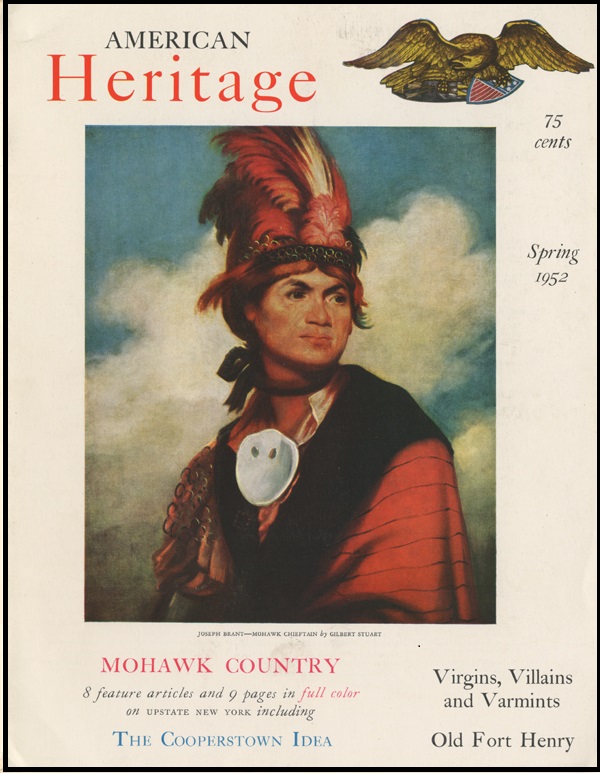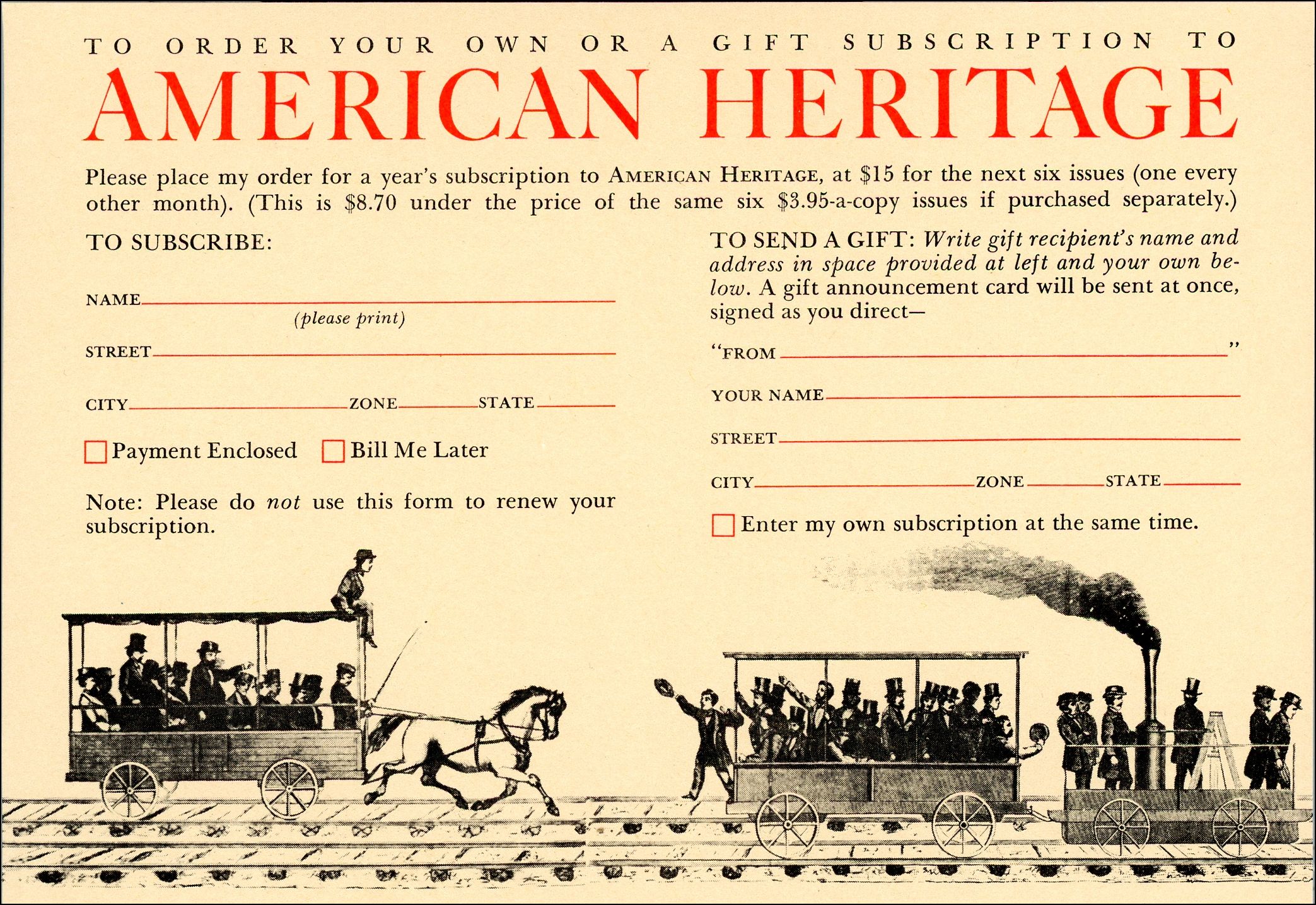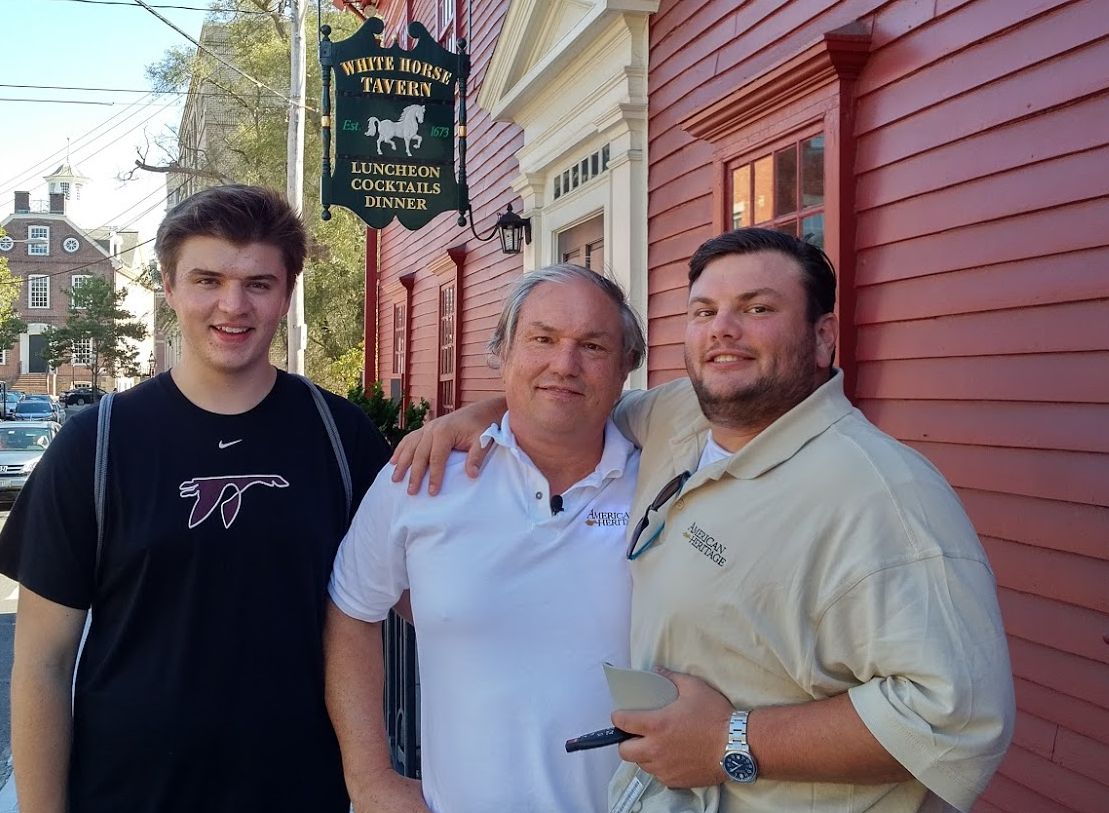Nearing its 70th anniversary, the magazine was relaunched in digital format for 72,000 subscribers.
-
Spring 2018
Volume63Issue1
In 1958, my father was honored to join the staff of American Heritage, one of America’s most revered magazines, eventually becoming its Managing Editor and helping many historians strengthen their writing. One of my most treasured possessions is a handwritten letter sent to my father by John Dos Passos. The famous novelist and friend of Ernest Hemingway wrote several articles for American Heritage on Thomas Jefferson, Aaron Burr, and Robert Morris, and my father was one of his editors.

Those essays by Dos Passos are part of a priceless archive and tradition that Edwin Grosvenor and a few fellow volunteers are trying to save and continue. American Heritage Magazine started out 70 years ago as a small journal published by the American Association for State and Local History, the association for historical societies. AASLH gave the magazine its iconic name from its mission statement, which was “to get Americans in touch with their shared heritage.”
See "Golden Anniversary" about the magazine's history in the November/December 2004 issue.
In 1954, AASLH sold the magazine to a brilliant quartet of skilled writers and editors; James Parton, Oliver Jensen, Joseph J. Thorndike and founding editor and Pulitzer Prize winner Bruce Catton. These four, along with a talented cast of contributors such as David McCullough, Thomas Fleming, Barbara W. Tuchman and John A. Garraty told America’s story and told it brilliantly.
American Heritage made it a point to illuminate the small corners and forgotten byways of our country’s past as well as highlighting the big moments in our story. The debut issue was published in December 1954 and continued six times a year, all in beautifully illustrated, 120-page hardbound editions and all without a shred of advertising. Their perseverance, and a bit of a gambler’s temperament, paid off handsomely, with subscriptions skyrocketing from 10,000 to 300,000 by 1959.
American Heritage in its early maturity was “the best place I ever worked as an employee," says former editor David McCullough. "There was a minimum of office bitterness, gossip, scandal, or jealousy. We had too much to do and too much fun doing it. People were enthusiastic about the magazine, about history, about the success of the publishing company. They were receptive to new ideas, with very high editorial standards, high accuracy, and quality of writing. They delivered in the sense that they provided to the subscriber a magazine that more than lived up to its advanced promises. As an employee you felt like you were cast in a hit show with great people.”
The rising costs of publishing in hardcover eventually forced American Heritage to switch to 80-page softcover editions in the late 1970s, but with the same commitment to excellence. The Forbes family bought the magazine in 1986, and led by editors Byron Dobell and Richard Snow it was a finalist twelve times for a prestigious National Magazine Award, winning three times including twice for the top prize, General Excellence.
But in May 2007, Forbes announced it was ending publication of American Heritage.
To Edwin S. Grosvenor, it was unacceptable to lose such a cherished institution, and he and some partners purchased it for $500,000 along with $10 million in subscription liabilities. His partners included prominent history supporters Albert H. Small, Robert H. Smith, and his son David Bruce Smith.
“My father had a subscription and like so many people I read it as a boy,” Grosvenor recalls. “In fact, after my father died my mother dutifully continued to subscribe to the magazine and stacked them up on the library shelves to keep the collection going.”
Grosvenor, born in Washington D.C. in 1951, has writing, editing and a love of travel in his blood, earning a B.A. from Yale and a MS in Journalism and an MBA, both from Columbia University. His grandfather Gilbert H. Grosvenor was editor of National Geographic for more than fifty years starting in 1903 and the torch was eventually passed to his father, Melville B. Grosvenor, who edited the magazine from 1957 to 1967. Edwin said his father was a true lover of history and made it a point to take him on as many historical excursions across America as he could. Places such as Monticello, Colonial Williamsburg, Fort Ticonderoga, and Saratoga,
“I just naturally fell in love with history and felt so strongly that American Heritage was a tradition that had to be kept alive,” he said.
When Forbes finally decided to sell, it was at a time when the magazine was thought to be on its last legs and was noted “as a kind of obituary” in an article in the New York Times . After protracted negotiations Grosvenor became the owner of the magazine in April 2008.
“My feeling was take it back to what American Heritage stands for and that is trusted good historical writing by the leading historians of the day that is accessible to a broad audience,” he said. “I published articles by historians such as David McCullough, David Hackett Fisher, and Joe Ellis. Those are the kind of writers I felt strongly that we needed to be publishing.”
But Grosvenor notes that immediately after the purchase, “the stock market tanked and nobody was investing in anything, so I was kind of left holding the bag.” He pressed on, however, and hired John F. Ross, from Smithsonian Magazine, as the Executive Editor and Cindy Scudder as Art Director, who had been with National Geographic for many years.
“The three of us decided to see if we could turn it around,” he said.
Grosvenor said 2009 turned out to be a good year, achieving financial breakeven despite the terrible economic downturn across the country. This was followed, optimistically, by the 60th Anniversary of the magazine that arrived in the winter of 2010, with writing by 14 Pulitzer Prize-winning historians.
“It had been losing $1.5 million a year before the recession and I took it over and kept it alive during the recession,” he said. The magazine was taking in about $2.5 to $3 million in revenues, and basically breaking. “All the fundamentals were strong, and we had its sister magazine, Invention & Technology, which was also very strong,” he says.

But Grosvenor began to realize the extent of the seismic changes taking place in the publishing world. The $15 a year that the magazine was able to charge subscribers in 2012 was the same price charged in the early 1960s, 50 years before. “I can’t think of any other industry that has had such pressure on prices as magazine publishing,” he says.
By the summer of 2012, reality set in. “Every time we went to press I had to come up with $170,000 to pay the printing, paper and postage because our print orders were 160,000 copies,” he said. “In a recession without any investment money to speak of, it just wasn’t sustainable.” Grosvenor was forced to let the staff go and the last print edition rolled off the press that summer using all freelancers.
Since investors were few and far between, it took time for Grosvenor to build modest revenues back up. “We created about 190 e-books in the last few years and that has been a help. These were mostly books that we had published over the previous half-century, so we digitized and modernized them a bit, and released them as e-books,” he said. “It’s a nice steady income and keeps the brand going.”
But the problem was, American Heritage needed to update its 10-year-old website and build a system to track subscribers. “We did a Kickstarter campaign and raised $34,000,” he reports. “I was very grateful that 590 people give donations, even though we had the email addresses of only a small fraction of our subscriber base.” The website, www.americanheritage.com, was revamped and a first new digital issue published in Summer 2017.
Grosvenor said going forward, the idea for American Heritage is fairly simple. "We need to engage a wider audience of people who love American history. We're going to offer the magazine free for the first year to build the audience back up, and then once it has a stable website and more subscribers, we will ask for donations and perhaps charge a modest subscription fee that will include digital issues, access to the archive, and one printed issue a year. There has to be some revenue to pay the bills."

Grosvenor admits it can be difficult to interest people in the 25- to 40-age bracket in history, let alone to the magazine.
“I struggled even with my own two sons, to get them interested in history,” he says. “So I decided to take them on a tour of Revolutionary War taverns. We went to 44 taverns and it was really a lot of fun... they learned that most of the guys fighting in the American Revolution were actually their age, not stuffy old guys. Then they started reading little stories and pretty soon they’re running through old graveyards to see if they can find veterans.”
The has been the goal of American Heritage for more than half a century. “The best way to refuel an American’s sense of purpose and place in the world is to put him in his ancestors’ footsteps for a little while,” said one of its founders, Jim Parton, in a 1957 speech to the Annual Congress of Historical Societies. “Nothing so lights up history as the electricity inherent in the phrase ‘This is the place’ or ‘Here he stood’ or ‘Your grandfather lived like this.’”
Grosvenor hopes he can keep the magazine reminding Americans that we all are part of an epic that is still unfolding and will be ready, one day, to be received and read by generations to come.

